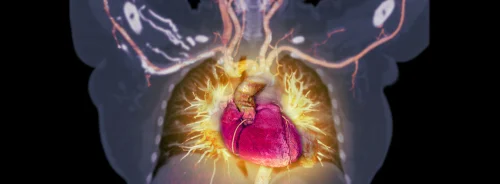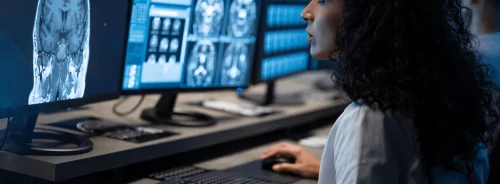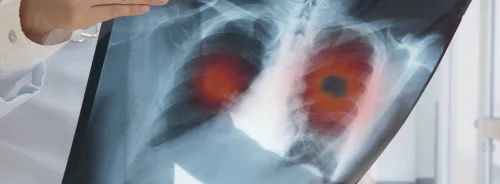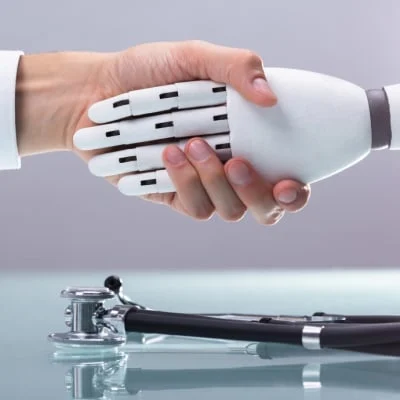Clearly, ChatGPT and other large language models (LLM) are one of the potentially most transformative developments in AI to date. Those generative models offer potentials not yet fully perceivable – especially if and how those could be applied in medicine and radiology. This session discussed potential applications of LLMs in radiology, from documentation and report generation, to teaching and even academic writing.
The future of reporting and documentation
Philippe Puech (France) stressed in his lecture that the predominant method of radiology reporting remains largely unstructured, leading to issues such as decreased quality control, difficulties in indexing for advanced searches, and challenges in interoperability with hospital information systems. As a result, pertinent information often gets lost amidst verbosity, leading to potential oversights and inefficiencies in patient care. To address these challenges, there is a pressing need for the structuring of data, standardization of reporting practices, and increased productivity. The emergence of guidelines and scoring systems further underscores the necessity for standardized reporting methodologies.
One longstanding solution to these challenges has been the development of structured reporting templates, such as the DICOM Structured Report standard. However, while such templates offer a degree of standardization, they often lack flexibility and efficient tools for customization. Several software solutions have emerged to address these shortcomings, offering templated reporting with intuitive interfaces and integration with various imaging modalities. These solutions streamline the reporting process and ensure adherence to specialty-specific standards, such as those for prostate MRI.
AI-powered tools can assist radiologists in tasks ranging from data analysis and interpretation to report generation and validation. Before interpretation, AI algorithms can analyse patient data, extract relevant information from electronic medical records, and even suggest potential alternate indications for examinations. During interpretation, AI can aid in image analysis, protocol compliance checks, and even propose structured reports based on findings.
Real-time analysis of report content by AI algorithms can identify inconsistencies, suggest relevant comparisons with prior imaging, and even propose potential diagnoses based on findings. Post-interpretation, AI can assist in report cleaning, formatting, and enrichment, ensuring clarity, conciseness, and adherence to standards. Moreover, AI-driven natural language processing (NLP) models, such as ChatGPT, can convert free-text reports into structured formats tailored to specific templates or simplified versions for patients and referring physicians.
While the integration of AI into radiology reporting holds tremendous promise for enhancing efficiency and patient care, challenges remain in terms of interoperability, reliability, and cost-effectiveness. Research efforts are ongoing to address these challenges and unlock the full potential of AI in radiology reporting.
The future of teaching and testing radiology residents
Laura Oleaga Zufiria (Spain) addressed in her lecture how LLMs could impact radiology training, which has been previously valued for its foundation in traditional methods. However, with the advent of new technologies, it has become evident that modernization is essential for staying relevant in the field. Radiology residents now find themselves tasked with mastering a plethora of tools and technologies, requiring educators to navigate this evolving landscape alongside their students.
Large language models and artificial intelligence (AI) are proving to be invaluable tools in teaching and training future radiologists. They offer educational materials However, it's crucial for educators to possess a deep understanding of these AI tools in order to effectively incorporate them into teaching curricula.
Educational institutions and healthcare organisations are increasingly embracing AI-powered learning platforms, which offer virtual classrooms, simulation environments, and interactive case studies. These platforms provide personalised learning experiences, catering to diverse learning preferences and allowing learners to pursue topics aligned with their interests and career goals, while allowing students to practice and refine their skills in a safe and controlled simulated environment.
Training programmes must incorporate AI modules to prepare residents for collaboration with AI systems in clinical practice. Residents need hands-on experience with AI tools, real-time feedback, and an understanding of workflow integration to effectively utilise these technologies in their daily work.
The shift towards competency-based training necessitates a focus on essential attributes beyond technical skills, including communication, ethical decision-making, and patient interaction. Radiology residents must be equipped with a clear understanding of data security and privacy regulations in an increasingly digital healthcare environment.
Assessment methods for radiology residents are also evolving, with a shift towards objective and standardised evaluation processes. Simulations and electronic platforms offer scalable and interactive assessment tools, providing immediate feedback and allowing residents to learn from their mistakes.
The concept of entrustable professional activities (EPAs) is gaining prominence in radiology training, providing guidance on the level of supervision needed by residents. EPAs focus on the acquisition of specific competencies, allowing residents to progressively demonstrate proficiency in various tasks and responsibilities. This approach is essential to prepare the next generation of radiologists to excel in an increasingly complex healthcare landscape.
AI apps for academic writing: if, when, and how to use it
Academic writing and research processes are not exempt of the impact made by LLMs, as Nicholas Landini (Italy) showed in his presentation.
While LLMs offer convenience and time-saving benefits, concerns arise regarding the reliability and accuracy of generated text, especially in scientific research. A review of published papers reveals a growing interest in the use of LLMs in research, highlighting potential applications such as idea generation, literature review, study design, data analysis, and text refinement. However, it's crucial to acknowledge biases in LLMs, including incomplete training data and a lack of transparency in their functioning.
Pr. Landini emphasised the importance of critically evaluating LLM outputs, noting discrepancies between different prompts and the need for clear, specific instructions to obtain accurate results. Additionally, concerns about plagiarism detection, data confidentiality, and the acceptability of LLM-assisted writing in scholarly publications are addressed.
In conclusion, while LLMs can be valuable aids in academic writing, their use should be approached with caution. Radiologists should exercise critical thinking, verify results against existing knowledge, and ensure proper citation of original sources to maintain academic integrity. By navigating the complexities of LLM-assisted writing with a critical eye, radiologists can leverage the benefits of these tools while upholding the standards of rigorous scientific inquiry.
Image Credit: iStock








